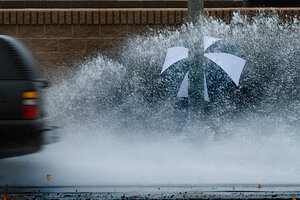California storms bring inconvenience, not devastation, so far
First responders are busy but not overwhelmed by rain storms that have lashed California for five days. Preparedness efforts include ways to channel mudslides, should they strike roads or homes.

A woman walks on the sidewalk as a passing motorist splashes water in Anaheim, Calif. on Monday. The stormy weather that brought record-setting rain began hitting the northern part of the state late Thursday and southern areas on Friday.
Bruce Chambers/The Orange County RegisterAP
Los Angeles
California is uncharacteristically soggy, but it has so far weathered the onslaught of drenching storms without massive interruptions of power, traffic nightmares, or serious damage to the public.
That's not to say first responders aren't busy. Vehicles are colliding on roads that, embedded with oil during the dry months, can cause hydroplaning once the rain slickens the oily surface. Tree limbs have fallen on homes, and rescue teams have been plucking motorists from trapped car and hikers from normally dry creek beds and isolated paths in parts of the southern California mountains.
But five days into the once-in-a-decade deluge, the good news is that no major mudslides have been reported in mountainous areas denuded by fires in October 2009, meaning homes at lower elevations are so far riding out the storms.
IN PICTURES: California's great storms of December 2010
Normally, it rains about 35 days a year in California, but the successive storm systems cued up to strike California appear likely to make 2010 a memorably sodden one.
Swift water and aerial rescue teams are plucking motorists from trapped cars, normally dry creek beds, and isolated hiking paths in several areas of southern California mountains as the National Weather Service says other storms are cued up, ready to strike.
Three to six inches of new rainfall are expected in foothill and mountain areas overnight Tuesday, according to Stuart Seto, a National Weather Service specialist in Oxnard, Calif. Emergency officials from Caltrans, the Los Angeles County Sheriffs Department, and the Los Angeles Police Department continue to prepare for possible flash floods and mudslides in every area of the region.
In the interest of preparedness, concrete barriers are in place to direct mudflows, should they materialize, and shovel trucks and earthmovers are ready to move liquid turf if it gets deposited on streets and highways. Residents are banding together to fill sandbags or create makeshift wooden fences to steer mud and rain from dwellings.
The rain is "on again, off again, but basically this makes my life really uncomfortable,” says Sal Kahlil, a carpenter who must traverse the region daily to different areas to work odd jobs. His morning and evening commutes to and from Pasadena have been jammed in several directions for five days.
Portions of major freeways in three counties (Los Angeles, Ventura, and Orange) – including US Highway 101 just east of downtown L.A. -- have been closed briefly because of flooding. Downtown Los Angeles has received 5-1/4 inches of rain since Friday morning, more than a third of the average annual precipitation.
In the Wrightwood area of Los Angeles, about 15 people were evacuated Monday night after the Sheep Creek Wash overflowed and threatened homes there, AP reported. About 21,000 Southern California Edison customers were without power part of Monday, according to spokeswoman Vanessa McGrady.
The record rainfall is not confined to the south. Oakhurst, in the Sierra Nevada foothills near Yosemite National Park, has had 13 inches of rain, and San Francisco International Airport had received 2.5 inches by early Tuesday morning. Nine to 13 feet of snow has been reported at higher elevations in the Sierras.
“That’s as high as my house,” says Mr. Kahlil. “Maybe I should get out of carpentry and into skiing.”
The record precipitation is being attributed to La Niña conditions, characterized by unusually cold ocean temperatures in the equatorial Pacific. El Niño conditions, by contrast, are characterized by unusually warm ocean temperatures there and produce a different weather pattern in California.
IN PICTURES: California's great storms of December 2010
